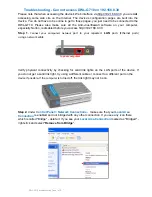
QTECH
Software Configuration Manual
4-56
·
Select a port from the ports in up state, if any, in the order of full duplex/high speed, full duplex/low
speed, half duplex/high speed, and half duplex/low speed, with the full duplex/high speed being the
most preferred. If two ports with the same duplex mode/speed pair are present, the one with the lower
port number wins out. Then, place those ports in up state with the same speed/duplex pair, link state and
basic configuration in selected state and all others in unselected state.
·
When all ports in the group are down, select the port with the lowest port number as the master port
and set all ports (including the master) in unselected state.
·
Place the ports that cannot aggregate with the master in unselected state, for example, as the result of
the cross-board aggregation restriction.
Manual aggregation limits the number of selected ports in an aggregation group. When the limit is exceeded,
the system changes the state of selected ports with greater port numbers to unselected until the number of selected
ports drops under the limit.
In addition, unless the master port should be selected, a port that joins the group after the limit is reached
will not be placed in selected state even if it should be in normal cases. This is to prevent the ongoing service on
selected ports from being interrupted. You need to avoid the situation however as the selected/unselected state of a
port may become different after a reboot.
4.4.2.3 Port Configuration Considerations in manual aggregation
As mentioned above, in a manual aggregation group, only ports with configurations consistent with those of
the master port can become selected. These configurations include port rate, duplex mode, link state and other basic
configurations.
You need to maintain the basic configurations of these ports manually to ensure consistency. As one
configuration change may involve multiple ports, this can become troublesome if you need to do that port by port. As
a solution, you may add the ports into an aggregation port group where you can make configuration for all member
ports.
When the configuration of some port in a manual aggregation group changes, the system does not remove
the aggregation; instead, it re-sets the selected/unselected state of the member ports and re-selects a master port.
4.4.3
Static LACP link aggregation
4.4.3.1 Overview
Static aggregations are created manually. After you add a port to a static aggregation, LACP is enabled on it
automatically.
4.4.3.2 Port states in static aggregation
In a static aggregation group, ports can be selected or unselected, where both can receive and transmit
LACPDUs but only selected ports can receive and transmit data frames. The selected port with the lowest port
number is the master port and all others are member ports.
All member ports that cannot aggregate with the master are placed in unselected state. These ports include
those using the basic configurations different from the master port or those located on a board different from the
master port because of the cross-board aggregation restriction.
Member ports in up state can be selected if they have the configuration same as that of the master port. The
number of selected ports however, is limited in a static aggregation group. When the limit is exceeded, the local and
remote systems negotiate the state of their ports as follows :
1) Compare the actor and partner system IDs that each comprises a system LACP priority plus a system MAC
address as follow :
·
First compare the system LACP priorities. The system with lower system LACP priority wins out.
·
If they are the same, compare the system MAC addresses. The system with the smaller ID has higher
priority. (the lower the LACP priority, the smaller the MAC address, and the smaller the device ID)
2) Compare the port IDs that each comprises a port LACP priority and a port number on the system with higher ID as
follows :
·
Compare the port LACP priorities. The port with lower port LACP priority wins out.
·
If two ports with the same port LACP priority are present, compare their port numbers. The state of the
ports with lower IDs then change to selected and the state of the ports with higher IDs to unselected, so
does the state of their corresponding remote ports. (the lower the LACP priority, the smaller the port
number, and the smaller the port ID)
















































